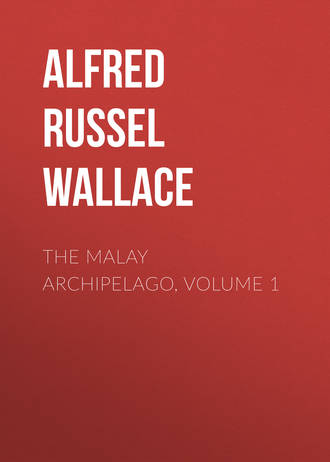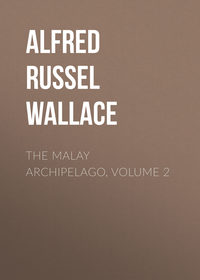 полная версия
полная версияThe Malay Archipelago, Volume 1
I have rarely enjoyed myself more than during my residence here. As I sat taking my coffee at six in the morning, rare birds would often be seen on some tree close by, when I would hastily sally out in my slippers, and perhaps secure a prize I had been seeking after for weeks. The great hornbills of Celebes (Buceros cassidix) would often come with loud-flapping wings, and perch upon a lofty tree just in front of me; and the black baboon-monkeys, Cynopithecus nigrescens, often stared down in astonishment at such an intrusion into their domains while at night herds of wild pigs roamed about the house, devouring refuse, and obliging us to put away everything eatable or breakable from our little cooking-house. A few minutes' search on the fallen trees around my house at sunrise and sunset, would often produce me more beetles than I would meet with in a day's collecting, and odd moments could be made valuable which when living in villages or at a distance from the forest are inevitably wasted. Where the sugar-palms were dripping with sap, flies congregated in immense numbers, and it was by spending half an hour at these when I had the time to spare, that I obtained the finest and most remarkable collection of this group of insects that I have ever made.
Then what delightful hours I passed wandering up and down the dry river-courses, full of water-holes and rocks and fallen trees, and overshadowed by magnificent vegetation. I soon got to know every hole and rock and stump, and came up to each with cautious step and bated breath to see what treasures it would produce. At one place I would find a little crowd of the rare butterfly Tachyris zarinda, which would rise up at my approach, and display their vivid orange and cinnabar-red wings, while among them would flutter a few of the fine blue-banded Papilios. Where leafy branches hung over the gully, I might expect to find a grand Ornithoptera at rest and an easy prey. At certain rotten trunks I was sure to get the curious little tiger beetle, Therates flavilabris. In the denser thickets I would capture the small metal-blue butterflies (Amblypodia) sitting on the leaves, as well as some rare and beautiful leaf-beetles of the families Hispidae and Chrysomelidae.
I found that the rotten jack-fruits were very attractive to many beetles, and used to split them partly open and lay them about in the forest near my house to rot. A morning's search at these often produced me a score of species—Staphylinidae, Nitidulidae, Onthophagi, and minute Carabidae, being the most abundant. Now and then the "sagueir" makers brought me a fine rosechafer (Sternoplus schaumii) which they found licking up the sweet sap. Almost the only new birds I met with for some time were a handsome ground thrush (Pitta celebensis), and a beautiful violet-crowned dove (Ptilonopus celebensis), both very similar to birds I had recently obtained at Aru, but of distinct species.
About the latter part of September a heavy shower of rain fell, admonishing us that we might soon expect wet weather, much to the advantage of the baked-up country. I therefore determined to pay a visit to the falls of the Maros river, situated at the point where it issues from the mountains—a spot often visited by travellers and considered very beautiful. Mr. M. lent me a horse, and I obtained a guide from a neighbouring village; and taking one of my men with me, we started at six in the morning, and after a ride of two hours over the flat rice-fields skirting the mountains which rose in grand precipices on our left, we reached the river about half-way between Maros and the falls, and thence had a good bridle-road to our destination, which we reached in another hour. The hills had closed in around us as we advanced; and when we reached a ruinous shed which had been erected for the accommodation of visitors, we found ourselves in a flat-bottomed valley about a quarter of a mile wide, bounded by precipitous and often overhanging limestone rocks. So far the ground had been cultivated, but it now became covered with bushes and large scattered trees.
As soon as my scanty baggage had arrived and was duly deposited in the shed, I started off alone for the fall, which was about a quarter of a mile further on. The river is here about twenty yards wide, and issues from a chasm between two vertical walls of limestone, over a rounded mass of basaltic rock about forty feet high, forming two curves separated by a slight ledge. The water spreads beautifully over this surface in a thin sheet of foam, which curls and eddies in a succession of concentric cones until it falls into a fine deep pool below. Close to the very edge of the fall a narrow and very rugged path leads to the river above, and thence continues close under the precipice along the water's edge, or sometimes in the water, for a few hundred yards, after which the rocks recede a little, and leave a wooded bank on one side, along which the path is continued, until in about half a mile, a second and smaller fall is reached. Here the river seems to issue from a cavern, the rocks having fallen from above so as to block up the channel and bar further progress. The fall itself can only be reached by a path which ascends behind a huge slice of rock which has partly fallen away from the mountain, leaving a space two or three feet wide, but disclosing a dark chasm descending into the bowels of the mountain, and which, having visited several such, I had no great curiosity to explore.
Crossing the stream a little below the upper fall, the path ascends a steep slope for about five hundred feet, and passing through a gap enters a narrow valley, shut in by walls of rock absolutely perpendicular and of great height. Half a mile further this valley turns abruptly to the right, and becomes a mere rift in the mountain. This extends another half mile, the walls gradually approaching until they are only two feet apart, and the bottom rising steeply to a pass which leads probably into another valley, but which I had no time to explore. Returning to where this rift had begun the main path turns up to the left in a sort of gully, and reaches a summit over which a fine natural arch of rock passes at a height of about fifty feet. Thence was a steep descent through thick jungle with glimpses of precipices and distant rocky mountains, probably leading into the main river valley again. This was a most tempting region to explore, but there were several reasons why I could go no further. I had no guide, and no permission to enter the Bugis territories, and as the rains might at any time set in, I might be prevented from returning by the flooding of the river. I therefore devoted myself during the short time of my visit to obtaining what knowledge I could of the natural productions of the place.
The narrow chasms produced several fine insects quite new to me, and one new bird, the curious Phlaegenas tristigmata, a large ground pigeon with yellow breast and crown, and purple neck. This rugged path is the highway from Maros to the Bugis country beyond the mountains. During the rainy season it is quite impassable, the river filling its bed and rushing between perpendicular cliffs many hundred feet high. Even at the time of my visit it was most precipitous and fatiguing, yet women and children came over it daily, and men carrying heavy loads of palm sugar (of very little value). It was along the path between the lower and the upper falls, and about the margin of the upper pool, that I found most insects. The large semi-transparent butterfly, Idea tondana, flew lazily along by dozens, and it was here that I at length obtained an insect which I had hoped but hardly expected to meet with—the magnificent Papilio androcles, one of the largest and rarest known swallow-tailed butterflies. During my four days' stay at the falls, I was so fortunate as to obtain six good specimens. As this beautiful creature flies, the long white tails flicker like streamers, and when settled on the beach it carries them raised upwards, as if to preserve them from injury. It is scarce even here, as I did not see more than a dozen specimens in all, and had to follow many of them up and down the river's bank repeatedly before I succeeded in their capture. When the sun shone hottest, about noon, the moist beach of the pool below the upper fall presented a beautiful sight, being dotted with groups of gay butterflies—orange, yellow, white, blue, and green—which on being disturbed rose into the air by hundreds, forming clouds of variegated colours.
Such gorges, chasms, and precipices here abound, as I have nowhere seen in the Archipelago. A sloping surface is scarcely anywhere to be found, huge walls and rugged masses of rock terminating all the mountains and enclosing the valleys. In many parts there are vertical or even overhanging precipices five or six hundred feet high, yet completely clothed with a tapestry of vegetation. Ferns, Pandanaceae, shrubs, creepers, and even forest trees, are mingled in an evergreen network, through the interstices of which appears the white limestone rock or the dark holes and chasms with which it abounds. These precipices are enabled to sustain such an amount of vegetation by their peculiar structure. Their surfaces are very irregular, broken into holes and fissures, with ledges overhanging the mouths of gloomy caverns; but from each projecting part have descended stalactites, often forming a wild gothic tracery over the caves and receding hollows, and affording an admirable support to the roots of the shrubs, trees, and creepers, which luxuriate in the warm pure atmosphere and the gentle moisture which constantly exudes from the rocks. In places where the precipice offers smooth surfaces of solid rock, it remains quite bare, or only stained with lichens, and dotted with clumps of ferns that grow on the small ledges and in the minutest crevices.
The reader who is familiar with tropical nature only through the medium of books and botanical gardens will picture to himself in such a spot many other natural beauties. He will think that I have unaccountably forgotten to mention the brilliant flowers, which, in gorgeous masses of crimson, gold or azure, must spangle these verdant precipices, hang over the cascade, and adorn the margin of the mountain stream. But what is the reality? In vain did I gaze over these vast walls of verdure, among the pendant creepers and bushy shrubs, all around the cascade on the river's bank, or in the deep caverns and gloomy fissures—not one single spot of bright colour could be seen, not one single tree or bush or creeper bore a flower sufficiently conspicuous to form an object in the landscape. In every direction the eye rested on green foliage and mottled rock. There was infinite variety in the colour and aspect of the foliage; there was grandeur in the rocky masses and in the exuberant luxuriance of the vegetation; but there was no brilliancy of colour, none of those bright flowers and gorgeous masses of blossom so generally considered to be everywhere present in the tropics. I have here given an accurate sketch of a luxuriant tropical scene as noted down on the spot, and its general characteristics as regards colour have been so often repeated, both in South America and over many thousand miles in the Eastern tropics, that I am driven to conclude that it represents the general aspect of nature at the equatorial (that is, the most tropical) parts of the tropical regions.
How is it then, that the descriptions of travellers generally give a very different idea? and where, it may be asked, are the glorious flowers that we know do exist in the tropics? These questions can be easily answered. The fine tropical flowering-plants cultivated in our hothouses have been culled from the most varied regions, and therefore give a most erroneous idea of their abundance in any one region. Many of them are very rare, others extremely local, while a considerable number inhabit the more arid regions of Africa and India, in which tropical vegetation does not exhibit itself in its usual luxuriance. Fine and varied foliage, rather than gay flowers, is more characteristic of those parts where tropical vegetation attains its highest development, and in such districts each kind of flower seldom lasts in perfection more than a few weeks, or sometimes a few days. In every locality a lengthened residence will show an abundance of magnificent and gaily-blossomed plants, but they have to be sought for, and are rarely at any one time or place so abundant as to form a perceptible feature in the landscape. But it has been the custom of travellers to describe and group together all the fine plants they have met with during a long journey, and thus produce the effect of a gay and flower-painted landscape. They have rarely studied and described individual scenes where vegetation was most luxuriant and beautiful, and fairly stated what effect was produced in them by flowers. I have done so frequently, and the result of these examinations has convinced me that the bright colours of flowers have a much greater influence on the general aspect of nature in temperate than in tropical climates. During twelve years spent amid the grandest tropical vegetation, I have seen nothing comparable to the effect produced on our landscapes by gorse, broom, heather, wild hyacinths, hawthorn, purple orchises, and buttercups.
The geological structure of this part of Celebes is interesting. The limestone mountains, though of great extent, seem to be entirely superficial, resting on a basis of basalt which in some places forms low rounded hills between the more precipitous mountains. In the rocky beds of the streams basalt is almost always found, and it is a step in this rock which forms the cascade already described. From it the limestone precipices rise abruptly; and in ascending the little stairway along the side of the fall, you step two or three times from one rock on to the other—the limestone dry and rough, being worn by the water and rains into sharp ridges and honeycombed holes—the basalt moist, even, and worn smooth and slippery by the passage of bare-footed pedestrians. The solubility of the limestone by rain-water is well seen in the little blocks and peaks which rise thickly through the soil of the alluvial plains as you approach the mountains. They are all skittle-shaped, larger in the middle than at the base, the greatest diameter occurring at the height to which the country is flooded in the wet season, and thence decreasing regularly to the ground. Many of them overhang considerably, and some of the slenderer pillars appear to stand upon a point. When the rock is less solid it becomes curiously honeycombed by the rains of successive winters, and I noticed some masses reduced to a complete network of stone through which light could be seen in every direction.
From these mountains to the sea extends a perfectly flat alluvial plain, with no indication that water would accumulate at a great depth beneath it, yet the authorities at Macassar have spent much money in boring a well a thousand feet deep in hope of getting a supply of water like that obtained by the Artesian wells in the London and Paris basins. It is not to be wondered at that the attempt was unsuccessful.
Returning to my forest hut, I continued my daily search after birds and insects. The weather, however, became dreadfully hot and dry, every drop of water disappearing from the pools and rock-holes, and with it the insects which frequented them. Only one group remained unaffected by the intense drought; the Diptera, or two-winged flies, continued as plentifully as ever, and on these I was almost compelled to concentrate my attention for a week or two, by which means I increased my collection of that Order to about two hundred species. I also continued to obtain a few new birds, among which were two or three kinds of small hawks and falcons, a beautiful brush-tongued paroquet, Trichoglossus ornatus, and a rare black and white crow, Corvus advena.
At length, about the middle of October, after several gloomy days, down came a deluge of rain which continued to fall almost every afternoon, showing that the early part of the wet season had commenced. I hoped now to get a good harvest of insects, and in some respects I was not disappointed. Beetles became much more numerous, and under a thick bed of leaves that had accumulated on some rocks by the side of a forest stream, I found an abundance of Carabidae, a family generally scarce in the tropics. The butterflies, however, disappeared. Two of my servants were attacked with fever, dysentery, and swelled feet, just at the time that the third had left me, and for some days they both lay groaning in the house. When they got a little better I was attacked myself, and as my stores were nearly finished and everything was getting very damp, I was obliged to prepare for my return to Macassar, especially as the strong westerly winds would render the passage in a small open boat disagreeable, if not dangerous.
Since the rains began, numbers of huge millipedes, as thick as one's finger and eight or ten inches long, crawled about everywhere—in the paths, on trees, about the house—and one morning when I got up I even found one in my bed! They were generally of a dull lead colour or of a deep brick red, and were very nasty-looking things to be coming everywhere in one's way, although quite harmless. Snakes too began to show themselves. I killed two of a very abundant species—big-headed, and of a bright green colour, which lie coiled up on leaves and shrubs and can scarcely be seen until one is close upon them. Brown snakes got into my net while beating among dead leaves for insects, and made me rather cautious about inserting my hand until I knew what kind of game I had captured. The fields and meadows which had been parched and sterile, now became suddenly covered with fine long grass; the river-bed where I had so many times walked over burning rocks, was now a deep and rapid stream; and numbers of herbaceous plants and shrubs were everywhere springing up and bursting into flower. I found plenty of new insects, and if I had had a good, roomy, water-and-wind-proof house, I should perhaps have stayed during the wet season, as I feel sure many things can then be obtained which are to be found at no other time. With my summer hut, however, this was impossible. During the heavy rains a fine drizzly mist penetrated into every part of it, and I began to have the greatest difficulty in keeping my specimens dry.
Early in November I returned to Macassar, and having packed up my collections, started in the Dutch mail steamer for Amboyna and Ternate. Leaving this part of my journey for the present, I will in the next CHAPTER conclude my account of Celebes, by describing the extreme northern part of the island which I visited two years later.
CHAPTER XVII. CELEBES
(MENADO, JUNE TO SEPTEMBER, 1859.)IT was after my residence at Timor-Coupang that I visited the northeastern extremity of Celebes, touching Banda, Amboyna, and Ternate on my way. I reached Menado on the 10th of June, 1859, and was very kindly received by Mr. Tower, an Englishman, but a very old resident in Menado, where he carries on a general business. He introduced me to Mr. L. Duivenboden (whose father had been my friend at Ternate), who had much taste for natural history; and to Mr. Neys, a native of Menado, but who was educated at Calcutta, and to whom Dutch, English, and Malay were equally mother-tongues. All these gentlemen showed me the greatest kindness, accompanied me in my earliest walks about the country, and assisted me by every means in their power. I spent a week in the town very pleasantly, making explorations and inquiries after a good collecting station, which I had much difficulty in finding, owing to the wide cultivation of coffee and cacao, which has led to the clearing away of the forests for many miles around the town, and over extensive districts far into the interior.
The little town of Menado is one of the prettiest in the East. It has the appearance of a large garden containing rows of rustic villas with broad paths between, forming streets generally at right angles with each other. Good roads branch off in several directions towards the interior, with a succession of pretty cottages, neat gardens, and thriving plantations, interspersed with wildernesses of fruit trees. To the west and south the country is mountainous, with groups of fine volcanic peaks 6,000 or 7,000 feet high, forming grand and picturesque backgrounds to the landscape.
The inhabitants of Minahasa (as this part of Celebes is called) differ much from those of all the rest of the island, and in fact from any other people in the Archipelago. They are of a light-brown or yellow tint, often approaching the fairness of a European; of a rather short stature, stout and well-made; of an open and pleasing countenance, more or less disfigured as age increases by projecting check-bones; and with the usual long, straight, jet-black hair of the Malayan races. In some of the inland villages where they may be supposed to be of the purest race, both men and women are remarkably handsome; while nearer the coasts where the purity of their blood has been destroyed by the intermixture of other races, they approach to the ordinary types of the wild inhabitants of the surrounding countries.
In mental and moral characteristics they are also highly peculiar. They are remarkably quiet and gentle in disposition, submissive to the authority of those they consider their superiors, and easily induced to learn and adopt the habits of civilized people. They are clever mechanics, and seem capable of acquiring a considerable amount of intellectual education.
Up to a very recent period these people were thorough savages, and there are persons now living in Menado who remember a state of things identical with that described by the writers of the sixteenth and seventeenth centuries. The inhabitants of the several villages were distinct tribes, each under its own chief, speaking languages unintelligible to each other, and almost always at war. They built their houses elevated upon lofty posts to defend themselves from the attacks of their enemies. They were headhunters like the Dyaks of Borneo, and were said to be sometimes cannibals. When a chief died, his tomb was adorned with two fresh human heads; and if those of enemies could not be obtained, slaves were killed for the occasion. Human skulls were the great ornaments of the chiefs' houses. Strips of bark were their only dress. The country was a pathless wilderness, with small cultivated patches of rice and vegetables, or clumps of fruit-trees, diversifying the otherwise unbroken forest. Their religion was that naturally engendered in the undeveloped human mind by the contemplation of grand natural phenomena and the luxuriance of tropical nature. The burning mountain, the torrent and the lake, were the abode of their deities; and certain trees and birds were supposed to have special influence over men's actions and destiny. They held wild and exciting festivals to propitiate these deities or demons, and believed that men could be changed by them into animals—either during life or after death.
Here we have a picture of true savage life; of small isolated communities at war with all around them, subject to the wants and miseries of such a condition, drawing a precarious existence from the luxuriant soil, and living on, from generation to generation, with no desire for physical amelioration, and no prospect of moral advancement.
Such was their condition down to the year 1822, when the coffee-plant was first introduced, and experiments were made as to its cultivation. It was found to succeed admirably from fifteen hundred feet, up to four thousand feet above the sea. The chiefs of villages were induced to undertake its cultivation. Seed and native instructors were sent from Java; food was supplied to the labourers engaged in clearing and planting; a fixed price was established at which all coffee brought to the government collectors was to be paid for, and the village chiefs who now received the titles of "Majors" were to receive five percent of the produce. After a time, roads were made from the port of Menado up to the plateau, and smaller paths were cleared from village to village; missionaries settled in the more populous districts and opened schools; and Chinese traders penetrated to the interior and supplied clothing and other luxuries in exchange for the money which the sale of the coffee had produced.
At the same time, the country was divided into districts, and the system of "Controlleurs," which had worked so well in Java, was introduced. The "Controlleur" was a European, or a native of European blood, who was the general superintendent of the cultivation of the district, the adviser of the chiefs, the protector of the people, and the means of communication between both and the European Government. His duties obliged him to visit every village in succession once a month, and to send in a report on their condition to the Resident. As disputes between adjacent villages were now settled by appeal to a superior authority, the old and inconvenient semi-fortified houses were disused, and under the direction of the "Controlleurs" most of the houses were rebuilt on a neat and uniform plan. It was this interesting district which I was now about to visit.









